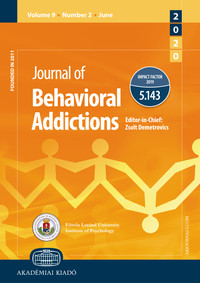Social anxiety and Internet gaming disorder: The role of motives and metacognitions
Social anxiety and Internet gaming disorder: The role of motives and metacognitions
Author(s): Claudia Marino, Natale Canale, Alessio Vieno, Gabriele Caselli, Luca Scacchi, Marcantonio M. SpadaSubject(s): Behaviorism
Published by: Akadémiai Kiadó
Keywords: internet gaming disorder; metacognitions about online gaming; social anxiety; preference for online social interactions (POSI); motives
Summary/Abstract: Background and aims. In recent years, Internet Gaming Disorder (IGD) has been recognized as a mental health problem. Although research has found that social anxiety, motives, the preference for online social interactions (POSI), and metacognitions about online gaming are independent predictors of IGD, less is known about their relative contribution to IGD. The aim of the current study was to model the relationship between social anxiety, motives, POSI, metacognitions about online gaming, and IGD. Methods. Five hundred and forty three Italian gamers who play more than 7 h a week (mean age = 23.9 years; SD = 6.15 years; 82.5% males) were included in the study. The pattern of relationships specified by the theoretical model was examined through path analysis. Results. Results showed that social anxiety was directly associated with four motives (escape, coping, fantasy, and recreation), POSI, and positive and negative metacognitions about online gaming, and IGD. The Sobel test showed that negative metacognitions about online gaming played the strongest mediating role in the relationship between social anxiety and IGD followed by escape, POSI, and positive metacognitions. The model accounted for 54% of the variance for IGD. Discussion and conclusions. Overall, our findings show that, along with motives and POSI, metacognitions about online gaming may play an important role in the association between social anxiety and IGD. The clinical and preventive implications of these findings are discussed.
Journal: Journal of Behavioral Addictions
- Issue Year: 9/2020
- Issue No: 3
- Page Range: 617-628
- Page Count: 12
- Language: English

